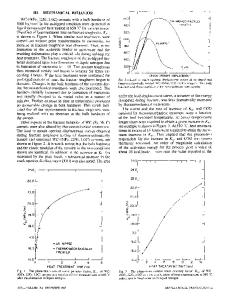Thermomechanical treatments of a 1050 pearlite steel
- PDF / 4,707,890 Bytes
- 14 Pages / 603.28 x 788 pts Page_size
- 21 Downloads / 328 Views
I.
II.
INTRODUCTION
IN 1970,
R.A. Grange ~ demonstrated that artificially oriented cementite lamellar structure could strengthen the ferrite matrix. The ultimate tensile strength (UTS), yield strength (YS), and elongation of eutectoid steel were improved simultaneously. Grange adopted the method of fast heat treatment-- up-quenching, i.e., annealing the samples at a temperature which is slightly above At3 for a short time, then air-cooled, in order to prevent the cementite lamellae from spheroidization and relieve the large part of the strains in the ferrite matrix by recrystallization. However, previous studies2'3 indicated that it was impossible to anneal out the stress effect without considerably changing the accompanying microstructure. For example, the cementite lamellae started to spheroidize within a very short time with the formation of substructures. This implied that cementite fiber strengthening was not the only reason for the improvement of mechanical properties. The formation of cell structures and subgrains (or grains) in the ferrite matrix seemed to play important roles) To investigate the evolution of microstructures and their effects on mechanical properties, a study of microstructureproperty relationship in thermomechanically treated 1050 steel has been carried out. 1050 plain carbon steel is one of the most widely used steels. The detailed relationship between microstructures and mechanical properties has not been well understood due to its complexity. Whether thermomechanical treatment can improve the mechanical properties and, if the answer is affirmative, in what way, are of great interest. By investigating the detailed relationship between microstructures and properties, a simple, economical thermomechanical treatment may be found to obtain optimal mechanical properties of the steel for industrial processing.
L.J. CHEN, Professor and Chairman, and H.C. CHENG, Graduate Student Research Assistant, are both with the Department of Materials Science and Engineering, National Tsing Hua University, Hsinchu, Taiwan, Republic of China. T.W. WU, formerly with the Department of Materials Science and Engineering, National Tsing Hua University, Hsinchu, Taiwan, is now with Division of Applied Science and Engineering, Harvard University, Cambridge, MA 02138. Manuscript submitted June 4, 1980. METALLURGICALTRANSACTIONS A
EXPERIMENTAL PROCEDURES
A. Sample Preparation and Heat Treatment The 1050 steel was received as 6 mm thick hot-rolled plates. The composition of the steel is listed in Table I. After homogenization at 1100 ~ for 2.5 hours, two sets of samples, one with fine pearlite (interlamellar spacing Sp - 0.3/zm) and the other with coarse pearlite (Sp - 1 to 2/xm) structure, were prepared. During the heat treatment, the steel specimens were covered with charcoal powder to minimize decarburization. The specimens were reduced 75 pct in thickness by cold rolling at room temperature. Two kinds of tensile samples were prepared for both as-rolled coarse and fine pearlite structure plates. For longitud
Data Loading...











